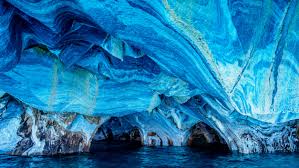The Marble Caves are natural rock formations with curved walls covered with swirling mineral patterns. They’re located on the shores of Lake General Carrera, a glacial lake in southern Chile. The lake feeds the caves with turquoise water, which fills the caves with blue light and gives them an otherworldly look.
The Marble Caves are so smooth, it looks like they were hollowed out with an ice cream scoop. But the caves were formed by the slow movement of the lake’s water, which dissolved the minerals in the rocks until the walls collapsed. Researchers believe this happened in the last 10,000 to 15,000 years, when glaciers retreated from the region and its stones were exposed to weathering.
“After the glaciers retreated, the lake formed and then the process of carving [the caves] began,” Francisco Hervé Allamand, a professor of geology at Andrés Bello National University in Chile and an honorary fellow of the Geological Society of America, told the BBC in 2019.
The stone in the caves was originally limestone, a sedimentary rock made of calcium carbonate. But it turned into marble, a metamorphic rock, under high heat and pressure before the caves opened, Hervé Allamand said. Limestone is one of the most soluble rocks in the world, meaning they are extremely vulnerable to erosion by water, he said.
The original limestone was formed closer to the equator than Chile is today and was swept south as tectonic plates shifted around the Earth millions of years ago, Hervé Allamand said. This grinding journey mangled the Earth’s crust and buried rocks so deep that they were exposed to searing temperatures of 570 to 750 degrees Fahrenheit (300 to 400 degrees Celsius).
Combined with the pressure of plate movement, this heat turned limestone into whitish-gray marble and created waves of brown and yellow rock where impurities were trapped in the limestone.
Reflections off the water in the Marble Caves lead to stunning images that change depending on the light and water levels. The bright blue color of the water is due to glacial silt, also known as “rock flour.”
This fine stone powder absorbs the shortest wavelengths of light — violet and indigo — and reflects mainly light blue and green light back to the surface, giving the water a turquoise hue. (Water absorbs longer wavelengths of light, giving rise to red, orange and yellow colors.) The turquoise water may look like a tropical sea, but its glacial origin means it’s freezing.
According to the travel website Swoop Patagonia, the Marble Caves are only accessible by water, and they’re best explored with a kayak, which enables visitors to wander in and out of the winding walls.



